Have you ever wondered where Camiguin Island is located in the Philippines? Is it near popular tourist destinations or tucked away in a remote corner? Prepare to be amazed as we unveil the fascinating location of this enchanting island.
Camiguin Island is nestled in the Bohol Sea, just 10 kilometers off the northern coast of mainland Mindanao. It belongs to Region X, the Northern Mindanao Region of the Philippines. Despite its small size, spanning approximately 238 square kilometers, Camiguin Island boasts an abundance of natural beauty and cultural treasures.
The coordinates of Camiguin Island are 9°10′N 124°43′E. Just imagine the stunning scenery that awaits you at these geographical coordinates.
This captivating island is often referred to as the “Island Born of Fire” due to its volcanic origins. Several volcanoes have sculpted Camiguin Island’s landscape, creating a unique and awe-inspiring setting that will leave you breathless.
Now that you know where Camiguin Island is located, it’s time to explore its hidden gems and embark on an unforgettable journey through this slice of paradise.
Key Takeaways:
- Camiguin Island is situated in the Bohol Sea, just off the northern coast of mainland Mindanao in the Philippines.
- It is part of Region X, the Northern Mindanao Region of the country.
- The island covers approximately 238 square kilometers in area.
- Camiguin Island’s coordinates are 9°10′N 124°43′E.
- Known as the “Island Born of Fire,” Camiguin Island boasts a unique landscape shaped by volcanic activity.
Camiguin Island’s Topography and Geography
Camiguin Island is a picturesque destination with diverse topography and geography. Its unique landscape offers visitors a variety of natural wonders to explore. One of the prominent features of the island is its lush interior forest reserves, known as the Mount Hibok-Hibok Protected Landscape. This expansive area has been recognized as an ASEAN Heritage Park, highlighting its ecological significance and biodiversity.
The topography of Camiguin Island ranges from rolling hills to volcanic peaks, providing breathtaking views from various vantage points. The highest elevation on the island is Mount Timpoong, soaring to an impressive height of 1,630 meters (5,350 feet) above sea level. This towering mountain offers adventurous hikers and climbers the chance to experience stunning panoramic vistas.
Surrounding the island is a well-maintained national road that stretches approximately 64 kilometers (40 miles). This road provides convenient access to the different attractions and towns located on Camiguin Island.
The coordinates of Camiguin Island are 9°10′N 124°43′E, situating it in the Bohol Sea off the northern coast of mainland Mindanao in the Philippines. These coordinates mark the island’s position on the globe, offering a geographical reference for travelers and researchers alike.
Getting to Camiguin Island
Planning a trip to Camiguin Island in the Philippines? Here’s everything you need to know about getting there.
The nearest airport to Camiguin Island is the Camiguin Airport, also known as Mambajao Airport. This airport serves as the main gateway for travelers visiting the island. You can fly directly to Camiguin Airport from Manila, the capital city of the Philippines.
If you’re coming from other parts of the country, such as Cebu, you can take a connecting flight to Camiguin Island. The distance between Cebu and Camiguin Island is approximately 127 kilometers (79 miles).
Alternatively, you have the option to travel by ferry or small plane from Cebu to Camiguin Island. The journey takes approximately 3 hours by ferry, while a small plane ride can get you there in around 40 minutes.
Whichever route you choose, you’ll be rewarded with breathtaking views and a warm welcome as you arrive on the beautiful shores of Camiguin Island.
Direct Flights to Camiguin Island
If you’re traveling from Manila, you have the convenience of direct flights to Camiguin Island. Several airlines operate regular flights between Manila and Camiguin Airport, making it easy to reach your destination. Flights take approximately 1 hour and 45 minutes, giving you plenty of time to sit back, relax, and enjoy the stunning aerial views of the Philippines.
Connecting Flights from Cebu
If you’re starting your journey from Cebu, you can choose to take a connecting flight to Camiguin Island. Cebu has excellent air connectivity and serves as a major transit hub for domestic flights in the Philippines. The approximate flight duration from Cebu to Camiguin Airport is 40 minutes. Prepare to be amazed as you fly over crystal-clear waters and witness the beauty of the islands below.
Seamless Ferry or Small Plane Journey
For those who prefer a more adventurous journey, you can travel from Cebu to Camiguin Island by ferry or small plane. The ferry ride takes approximately 3 hours and offers a scenic route through the Bohol Sea. Alternatively, you can take a small plane for a quick and convenient aerial journey. Both options provide unique perspectives of the Philippine archipelago and the opportunity to make unforgettable memories along the way.
Choose Your Path to Paradise
Whether you prefer the convenience of a direct flight or the thrill of an island-hopping adventure, getting to Camiguin Island is part of the experience. Prepare yourself for the natural beauty, warm hospitality, and captivating attractions that await you in this tropical paradise.
Exploring Camiguin Island’s Attractions
Camiguin Island is a treasure trove of natural wonders and cultural gems that will captivate any traveler. Whether you’re a nature enthusiast, history buff, or simply seeking relaxation, this island paradise has something for everyone. Here are some of the top tourist attractions that you shouldn’t miss during your visit to Camiguin Island:
- Sunken Cemetery: Located in Barangay Bonbon, Catarman, the Sunken Cemetery is a unique underwater site created by the volcanic eruption that submerged the old graveyard. Visitors can take a boat tour or go snorkeling and scuba diving to explore the eerie yet fascinating remnants of the cemetery.
- White Island: Just a short boat ride away from the mainland, White Island is an uninhabited sandbar with crystal clear turquoise waters and powdery white sand. It offers breathtaking views of Mount Hibok-Hibok and is perfect for swimming, sunbathing, and snorkeling.
- Tuasan Falls: Nestled in the heart of the jungle, Tuasan Falls is a scenic waterfall surrounded by lush greenery. It is an ideal spot for nature lovers and adventure seekers who can take a refreshing dip in its cool waters or hike along the nature trails.
- Ardent Hot Spring: If you’re in need of relaxation, head to Ardent Hot Spring, a natural hot spring located at the foothills of Mount Hibok-Hibok. Soak in the warm, therapeutic waters, surrounded by tropical foliage and serene views.
- Old Church Ruins in Catarman: The ruins of the Old Bonbon Church serve as a haunting reminder of the devastating volcanic eruption that occurred in 1871. These picturesque ruins are a testament to the island’s rich history and provide a unique backdrop for photography enthusiasts.
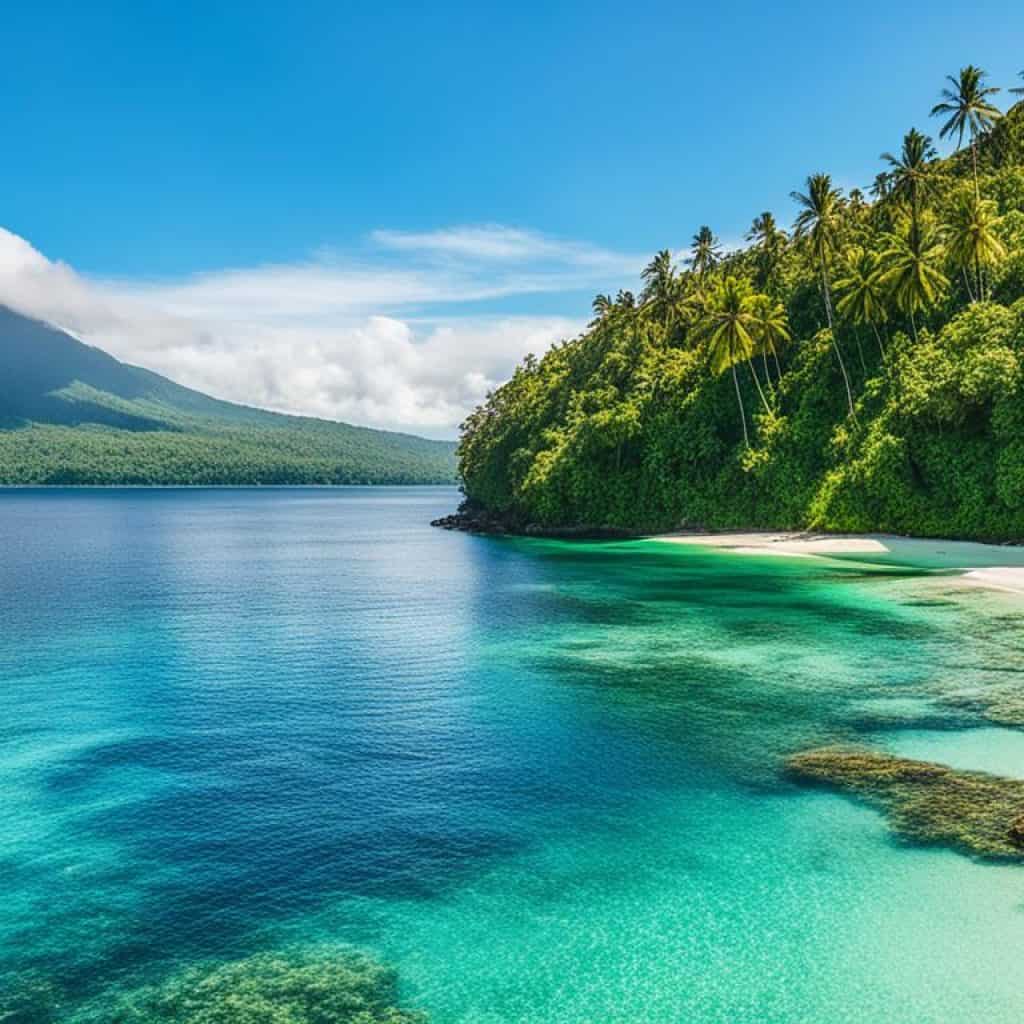
These are just a few of the many attractions that Camiguin Island has to offer. From mesmerizing waterfalls and pristine beaches to historical landmarks and cultural sites, this tropical paradise will leave you awestruck at every turn. Embark on a journey of discovery and create unforgettable memories on your visit to Camiguin Island.
Camiguin Island’s Rich Cultural Heritage
Camiguin Island is not only blessed with natural beauty, but it also boasts a rich cultural heritage that can be seen in its historical sites and traditions. The island is home to several National and Important Cultural Treasures, recognized and declared by the National Commission for Culture and the Arts. These treasures hold great significance in preserving the island’s history and showcasing its cultural identity.
1. Old Bonbon Church ruins in Catarman
The Old Bonbon Church ruins in Catarman is a captivating site that stands as a testament to the island’s Spanish colonial past. This Spanish-era church was tragically destroyed by the eruption of Mount Vulcan in 1871. Today, the remnants of the church serve as a solemn reminder of the island’s tumultuous history and attract visitors who appreciate its historical and architectural value.
2. Sunken Cemetery of Catarman
The Sunken Cemetery of Catarman is an extraordinary underwater burial site that was created following the volcanic eruption. As the name suggests, the cemetery is now submerged underwater, making it a unique and hauntingly beautiful diving spot. Divers can explore the underwater graves and witness the interplay between nature and history in this remarkable location.
3. Spanish-era watchtower in Guinsiliban
In Guinsiliban, visitors can find a well-preserved Spanish-era watchtower that played a crucial role in protecting the island against Moro pirates during the Spanish colonial period. The watchtower served as a lookout point, providing a vantage position to spot approaching vessels and raise alarms. Today, the watchtower stands as a symbol of resilience and a glimpse into Camiguin’s past.
4. Old Mambajao Fountain
The Old Mambajao Fountain is a historical site located in the town’s prominent rotonda. This iconic fountain serves as a tribute to Mambajao’s history, culture, and aspirations. A popular landmark on the island, it has become a symbol of community and civic pride, adding to the charm and character of Camiguin Island.
These significant cultural sites highlight the historical depth and diverse heritage of Camiguin Island. Exploring these treasures allows visitors to immerse themselves in the island’s rich cultural tapestry and gain a deeper understanding of its past.
Camiguin Island’s Local Dialects
Camiguin Island is a place of cultural diversity, where various local dialects are spoken by its residents. The primary languages on the island include Cebuano, Kinamigin, Tagalog, and English.
Cebuano is the most widely spoken language on Camiguin Island, serving as the lingua franca among the locals. It is commonly used in daily conversations, business transactions, and community gatherings.
Kinamigin is a distinct indigenous language spoken by a smaller population on the island. It is considered the northernmost variant of the Manobo languages and reflects the rich indigenous heritage of Camiguin’s inhabitants.
Tagalog and English are also commonly understood and used on Camiguin Island, especially in tourist areas. Tagalog is one of the national languages of the Philippines, while English is widely spoken as a second language, making it easier for visitors to communicate with locals.
These local dialects create a diverse linguistic landscape on Camiguin Island, adding to its cultural richness and offering visitors a chance to explore different linguistic traditions.
| Dialects | Main Language |
|---|---|
| Cebuano | Widely spoken language serving as the lingua franca among the locals |
| Kinamigin | A distinct indigenous language reflecting the rich indigenous heritage of the island |
| Tagalog | Commonly understood and used, especially in tourist areas |
| English | Widely spoken as a second language, facilitating communication with visitors |
Camiguin Island’s Income Classification
Camiguin Island, despite its natural beauty and vibrant tourism industry, has an income classification of 5th class. This classification is based on various economic indicators, including revenue, population, and development projects. Although Camiguin Island may have a relatively lower income compared to other regions in the Philippines, it is important to note that the island contributes significantly to the local economy through agriculture, fishing, and other livelihood activities.
Despite its income classification, Camiguin Island continues to thrive as a tourist destination, attracting visitors from all over the world. The island’s stunning landscapes, pristine beaches, and rich cultural heritage make it a sought-after destination for travelers seeking an authentic and immersive experience.
One of the main sources of income for Camiguin Island is its vibrant agriculture sector. The island is known for its fertile soil, abundant rainfall, and favorable climate, making it an ideal location for farming. Locals engage in the cultivation of various crops, including rice, corn, coconut, and tropical fruits. The island’s agricultural produce not only provides sustenance for the local community but also contributes to the overall economy.
In addition to agriculture, fishing plays a crucial role in Camiguin Island’s economy. The island is surrounded by rich fishing grounds, providing a livelihood for many local fishermen. Fresh seafood, such as fish, crabs, and prawns, are not only consumed by the locals but also serve as a delicacy for visitors. The fishing industry also supports businesses and establishments that provide seafood-related services, contributing further to the local economy.
Furthermore, the tourism industry in Camiguin Island generates income through various sectors, including accommodations, restaurants, transportation services, and tourist attractions. The island offers a range of accommodation options, from luxury resorts to budget-friendly guesthouses, catering to different preferences and budgets. Local restaurants showcase the island’s unique culinary offerings, incorporating fresh seafood and local flavors. Transportation services, such as tours and rentals, facilitate the exploration of the island’s natural wonders and cultural sites.
Through its diverse economic activities, Camiguin Island thrives despite its income classification. The island’s commitment to sustainable tourism practices and the preservation of its natural and cultural heritage ensures the continued growth and development of its economy. As travelers continue to discover the beauty of Camiguin Island, the local community benefits from the income generated, providing them with livelihood opportunities and enhancing their quality of life.
Recommended Itinerary for a Camiguin Island Trip
Planning a trip to Camiguin Island? Here’s a suggested itinerary to help you make the most of your visit. Whether you’re a nature enthusiast, adventure seeker, or culture lover, this itinerary offers a diverse range of experiences that showcase the island’s true beauty and charm.
Day 1: Arrival and Island Exploration
- Arrive at Camiguin Airport or take a ferry from Cebu to Camiguin Island.
- Check into your chosen accommodation and freshen up.
- Start your adventure by exploring the island’s natural wonders.
- Visit Mount Hibok-Hibok, an active volcano, for a challenging yet rewarding hike. Enjoy panoramic views of the island from the summit.
- Experience the refreshing waters of Tuasan Falls and Katibawasan Falls.
- End the day with a relaxing dip at White Island, a picturesque sandbar surrounded by crystal-clear waters.
Day 2: Cultural Immersion and Historical Sites
- Embark on a cultural journey by visiting the Sunken Cemetery, a unique underwater burial site formed during a volcanic eruption.
- Explore the ruins of Old Bonbon Church in Catarman, a significant historical site that showcases the island’s colonial past.
- Discover the historic Spanish-era watchtower in Guinsiliban and learn about its role in defending the island against pirate attacks.
- Take a break and savor traditional Kinamigin cuisine for lunch.
- Visit the Old Mambajao Fountain, a symbol of the town’s history and culture.
- End the day with a relaxing soak in the natural hot springs of Ardent Hibok-Hibok Spring Resort.
Day 3: Island Hopping and Beaches
- Embark on an exciting island hopping tour to explore the surrounding islets.
- Visit Mantigue Island, a marine sanctuary renowned for its colorful coral reefs and diverse marine life. Enjoy snorkeling and swimming in its pristine waters.
- Discover the mysterious and enchanting beauty of the White Island Sandbar.
- Indulge in a delicious seafood lunch at one of the local restaurants.
- Spend the afternoon relaxing on the black sand beaches of Yumbing or Agoho.
- Enjoy a peaceful sunset cruise before heading back to the mainland.
Day 4: Mountain Trekking and Local Experiences
- Embark on an adventure to conquer Mount Vulcan, the famous volcano that erupted and created the Sunken Cemetery.
- Challenge yourself with a trek to the summit and be rewarded with breathtaking views of the island and the surrounding sea.
- Visit Tangub Hot Spring, a hidden gem nestled in the mountains, and relax in its therapeutic waters.
- Take a break and immerse yourself in the local culture by visiting Mahinog’s local market and experiencing the vibrant atmosphere.
- End the day with a delightful sunset dinner at one of the beachfront restaurants.
With this suggested itinerary, you can explore the best of Camiguin Island’s natural wonders, historical sites, and cultural experiences. Remember to pack sunscreen, comfortable walking shoes, and your sense of adventure. Now, get ready to create unforgettable memories as you discover the hidden gems of Camiguin Island.
Best Time to Visit Camiguin Island
Planning a trip to Camiguin Island? Consider the timing of your visit to make the most of this beautiful destination. While Camiguin can be visited throughout the year due to its relatively mild climate, the best time to explore the island is during the dry season, which runs from December to May.
During the dry season, the weather in Camiguin is generally sunny and pleasant, creating perfect conditions for outdoor activities and exploring the island’s attractions. Whether you want to relax on the pristine beaches, hike through the lush forests, or visit the picturesque waterfalls, the dry season offers ideal weather for these activities.
However, it’s important to note that Camiguin Island may get crowded during peak travel periods, such as holidays and festivals. If you prefer a more peaceful and relaxed experience, consider visiting during the shoulder seasons, which are September to November and June to August. These months offer a balance between good weather and fewer crowds, allowing you to fully enjoy the island’s beauty at your own pace.
Now that you know the best time to visit Camiguin Island, start planning your trip and get ready to immerse yourself in the natural wonders and rich cultural heritage of this enchanting destination.
Key Highlights:
- The best time to visit Camiguin Island is during the dry season (December to May).
- The weather is generally sunny and pleasant, perfect for outdoor activities.
- Consider visiting during the shoulder seasons (September to November, June to August) for a more peaceful experience.
- Be mindful of peak travel periods, as the island may get crowded during holidays and festivals.
Accommodation Options in Camiguin Island
Camiguin Island offers a range of accommodation options to suit different budgets and preferences. Whether you’re looking for luxury resorts or budget-friendly guesthouses, there is something for everyone on this enchanting island.
If you’re seeking a truly indulgent experience, consider staying at Bahay Bakasyunan sa Camiguin resort. Situated on a beautiful beachfront, this resort offers nipa hut-style villas that provide an authentic island experience. With a swimming pool overlooking the sea, it’s the perfect place to relax and unwind.
For those on a tighter budget, there are homestays, cottages, and hotels scattered across different parts of the island. In the town of Mambajao, you’ll find a variety of guesthouses and small hotels that offer comfortable accommodations at affordable prices. If you’re interested in exploring the fishing village of Guinsiliban, there are a few budget-friendly options available there as well.
When it comes to choosing where to stay on Camiguin Island, it’s important to book your accommodation in advance, especially during peak travel seasons. This will help you secure your preferred choice and ensure a hassle-free trip.
Recommended Accommodation Options
| Accommodation | Location | Features |
|---|---|---|
| Bahay Bakasyunan sa Camiguin | Yumbing, Mambajao | – Beachfront location – Nipa hut-style villas – Swimming pool |
| Cottages by the Sea | Agoho, Mambajao | – Ocean view – Cozy cottages – Easy beach access |
| Pabua’s Cottage | Guinsiliban | – Quiet location – Native-style cottages – Garden setting |
| Camiguin Volcan Beach Eco Retreat & Dive Resort | Mahinog | – Beachfront property – Eco-friendly practices – Dive center |
These are just a few of the recommended accommodation options in Camiguin Island. Remember to consider your budget, preferred location, and desired amenities when making your choice. No matter where you stay, you’ll be able to enjoy the natural beauty and warm hospitality that Camiguin Island has to offer.
Safety and Travel Tips for Camiguin Island
When planning your trip to Camiguin Island, it’s important to prioritize safety and make the most of your experience. Here are some essential travel tips to keep in mind:
1. Research and Plan Ahead
Before you embark on your journey, take the time to research Camiguin Island’s attractions, local customs, and traditions. Familiarize yourself with the island’s geography and map out your itinerary to make the most of your time.
2. Pack Accordingly
Camiguin Island offers a tropical climate, so pack lightweight and breathable clothing suitable for warm weather. Don’t forget essentials such as sunscreen, insect repellent, a hat, and comfortable footwear for exploring the island’s natural wonders.
3. Follow Safety Guidelines
When visiting natural attractions such as waterfalls and hot springs, adhere to safety guidelines and warnings provided by local authorities. Respect any signs and barriers indicating potential hazards, and exercise caution when swimming or engaging in water activities.
4. Stay Hydrated
As you explore Camiguin Island, make sure to stay hydrated by carrying a water bottle with you. The tropical climate and outdoor activities can be demanding, so it’s important to drink plenty of water throughout the day.
5. Respect the Environment
Help preserve Camiguin Island’s natural beauty by practicing responsible tourism. Dispose of trash properly, avoid littering, and be mindful of your impact on the environment. Follow designated trails when hiking and respect wildlife and marine life during your explorations.
6. Engage with Locals
Immerse yourself in Camiguin Island’s rich culture by engaging with the friendly locals. Respect their customs and traditions, and be open to learning about their way of life. They can provide valuable insights and recommendations for your trip.
7. Be Mindful of Your Belongings
Keep a close eye on your belongings to ensure their safety. Avoid displaying valuable items in public and use secure lockers or safes provided by your accommodation. When out and about, carry only essential items and be cautious of your surroundings.
8. Stay Informed about Weather Conditions
Stay updated on the latest weather conditions and potential typhoon warnings during your visit to Camiguin Island. It’s advisable to check weather forecasts regularly and adjust your plans accordingly to ensure a safe and enjoyable trip.
“Safety should always be a top priority when exploring new destinations. By following these travel tips, you can have a memorable and worry-free experience in Camiguin Island.”
For emergency situations, save important contact numbers such as local authorities, your accommodation, and medical facilities in your phone or on a written list. It’s always better to be prepared for any unforeseen circumstances.
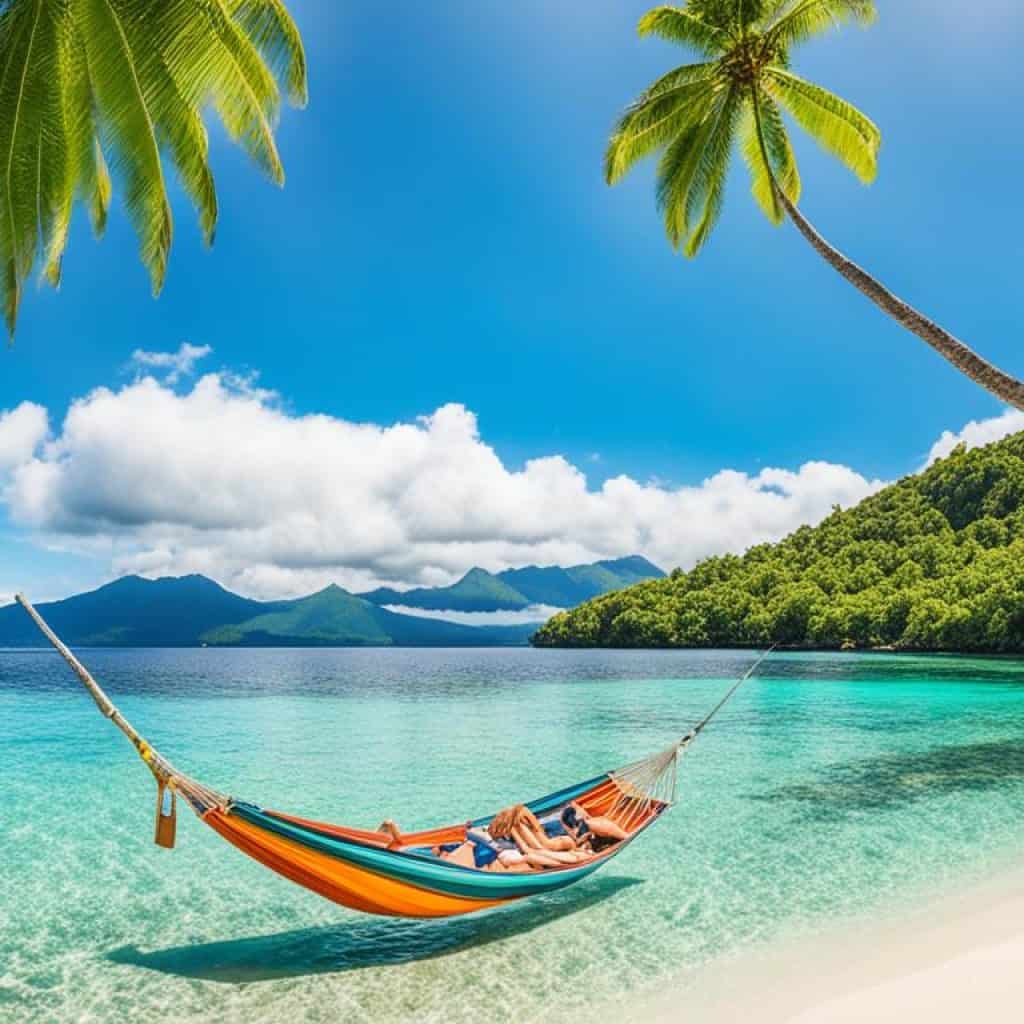
| Emergency Contacts: | Phone Number: |
|---|---|
| Tourism Office | 123-456-7890 |
| Local Police | 987-654-3210 |
| Medical Emergency | 555-123-4567 |
Environmental Conservation in Camiguin Island
Camiguin Island is committed to environmental conservation and sustainable tourism practices. The island is home to the Mount Hibok-Hibok Protected Landscape, which has been declared an ASEAN Heritage Park. This recognition highlights the importance of preserving the island’s diverse ecosystem.
The local government, in collaboration with various organizations, actively promotes environmental initiatives aimed at preserving Camiguin Island’s natural resources. These initiatives include:
- Waste reduction programs to minimize the impact on the environment
- Regular beach clean-ups to maintain the pristine condition of the coastline
- Conservation efforts for both marine and land resources
Travelers visiting Camiguin Island are encouraged to be responsible tourists by adopting eco-friendly habits during their stay. This includes following designated trails while exploring the island’s natural attractions and supporting local conservation efforts.
By prioritizing environmental conservation, Camiguin Island ensures the preservation of its natural beauty for future generations to enjoy.
Conclusion
Camiguin Island, located off the coast of mainland Mindanao in the Philippines, is a hidden gem in the Philippine archipelago. This tropical paradise is renowned for its stunning natural beauty and rich cultural heritage. Whether you’re looking for adventure, relaxation, or a chance to immerse yourself in local culture, Camiguin Island has something to offer.
From its picturesque sandbars and majestic waterfalls to its historical sites and diverse marine life, Camiguin Island provides a diverse range of experiences for travelers. The island’s prime location in the Bohol Sea offers breathtaking views and a serene atmosphere. It truly is a tropical paradise waiting to be explored.
Plan your trip to Camiguin Island and discover why it is one of the most captivating destinations in the Philippines. Whether you want to hike to the peak of Mount Hibok-Hibok, soak in the refreshing waters of Tuasan Falls, or explore the hidden treasures of the Sunken Cemetery, Camiguin Island will leave you in awe. So pack your bags, head to Camiguin Island, and create unforgettable memories in this enchanting destination.
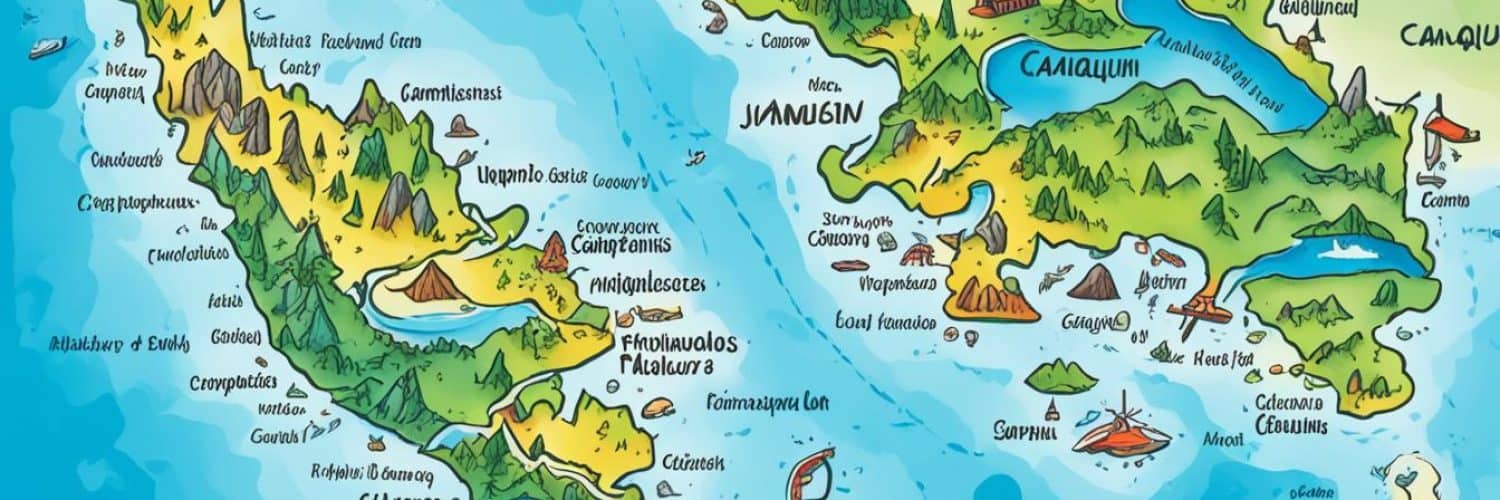
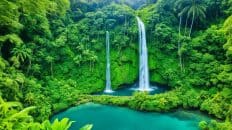
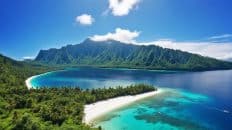















Add comment